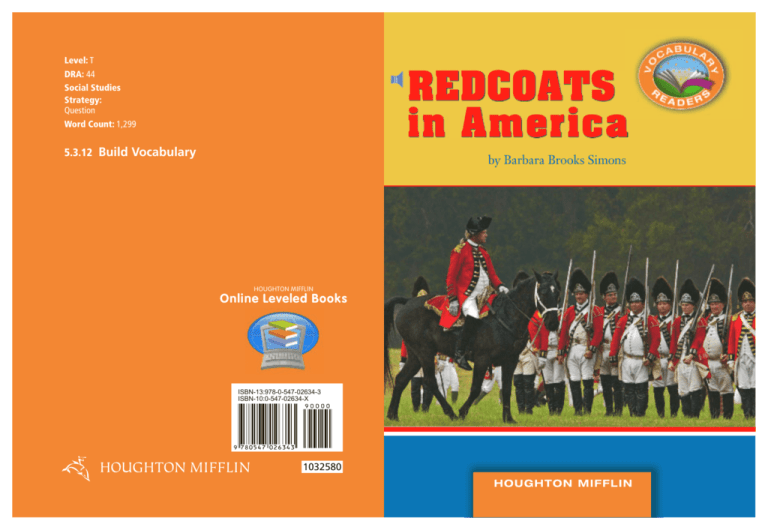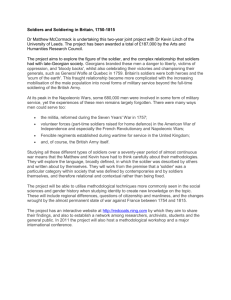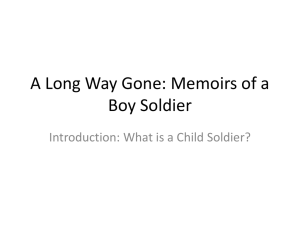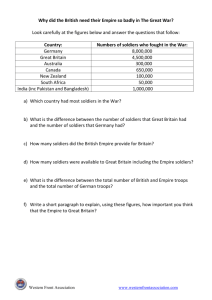
Level: T
DRA: 44
Social Studies
Strategy:
Question
Word Count: 1,299
REDCOATS
in America
5.3.12 Build Vocabulary
by Barbara Brooks Simons
HOUGHTON MIFFLIN
Online Leveled Books
ISBN-13:978-0-547-02634-3
ISBN-10:0-547-02634-X
1032580
H O UG H T O N M IF F L IN
REDCOATS
in America
by Barbara Brooks Simons
PHOTOGRAPHY CREDITS: Cover © N.Carter/North Wind Picture Archives. Title page The Granger Collection, New York.
2 © N.Carter/North Wind Picture Archives. 3 © N.Carter/North Wind Picture Archives. 5 Painting by Don Troiani
www.historicalimagebank.com. 6 © N.Carter/North Wind Picture Archives. 6-7 The Granger Collection, New York.
7 The Granger Collection, New York. 8 Library of Congress, LC-USZC4-6507. 9 (t) (b) www.historicalimagebank.com.
(m) C Squared Studios/Getty Images. 10 The Granger Collection, New York. 11 © Gary W. Carter/CORBIS. 12 (bkgd)
Photodisc/Getty Images. (inset) The Granger Collection, New York. 13 Painting by Don Troiani www.historicalimagebank.
com. 14 © Francis G. Mayer/CORBIS.
Copyright © by Houghton Mifflin Harcourt Publishing Company
All rights reserved. No part of this work may be reproduced or transmitted in any form or by any means, electronic or
mechanical, including photocopying or recording, or by any information storage and retrieval system, without the prior
written permission of the copyright owner unless such copying is expressly permitted by federal copyright law. Requests
for permission to make copies of any part of the work should be addressed to Houghton Mifflin Harcourt School Publishers,
Attn: Permissions, 6277 Sea Harbor Drive, Orlando, Florida 32887-6777.
Printed in China
ISBN-13: 978-0-547-02634-3
ISBN-10: 0-547-02634-X
1 2 3 4 5 6 7 8 0940 18 17 16 15 14 13 12 11
If you have received these materials as examination copies free of charge, Houghton Mifflin Harcourt School Publishers
retains title to the materials and they may not be resold. Resale of examination copies is strictly prohibited.
Possession of this publication in print format does not entitle users to convert this publication, or any portion of it, into
electronic format.
Table of Contents
Introduction
3
Chapter 1 A British Soldier’s Life
4
Chapter 2 At War in America
9
Chapter 3 Fighting for King George
12
Conclusion
14
5_02634X_VR3_2BL_REDCOATS.indd 2
1/2/08 3:29:49 PM
Introduction
In the late 1700s, America was a British colony
ruled by the king of England. He sent British soldiers
to America to make sure his laws were obeyed.
Americans were not happy with British rule.
They hated the British soldiers, who were called
“Redcoats” for the color of their uniforms. Some
wanted the king to repeal taxes they thought were
unfair. In time, many wanted independence from
Britain. That led to war.
British soldiers fought in America for six years.
Britain had the most powerful army in the world,
but the rebellious Americans won anyway. What
was life like for these soldiers far from home?
The British soldiers were considered the best
and most powerful in the world.
3
Chapter 1
A British Soldier’s Life
Life for a British soldier wasn’t easy. Even the
trip across the Atlantic Ocean was long and hard.
And once the soldier had arrived, he found a very
different land from what he was used to. Britain
was usually cool and rainy while America could be
very hot. In most cases, nothing quite fit for the
British soldiers.
What did a British soldier wear?
A soldier’s red wool coat was handsome with
colorful lapels and gold or silver trim. The coat
gave the British army its nickname—“Redcoats.”
But it was tight, hot, and itchy. These uniforms
proved to be ill suited for the American climate.
What did a British soldier carry?
The British soldier’s gun was nicknamed
“Brown Bess.” It was heavy and clumsy, weighing
15 pounds. It was over three feet long.
The soldier also wore a sword. On the march,
a soldier carried a lot more. His backpack held food
and a tin canteen, and he also carried ammunition,
tents, and blankets.
4
5_02634X_VR3_2BL_REDCOATS.indd 4
1/2/08 3:30:34 PM
A British soldier
seldom had a
clean shirt to
wear.
three-cornered hat
red coat
Brown Bess rifle
with bayonet
silver buttons
and trim
white vest
knee breeches
gaitors
boots
5
How were soldiers paid?
Badly! They got only about 6 to 8 pence a day.
That is much less than a dollar a day. British
coachmen and chimney sweeps earned more than
that. Paymasters took a few pence for shoes and
gun repairs, and a few more pence went to pay the
surgeon, or medical officer. Soldiers were left with
little money to spend on themselves.
How were soldiers treated?
Some officers were kind, but discipline was
strict. Punishments were harsh, even for small
crimes. The most common was flogging, which
was being whipped on the back.
Nicknames
British soldiers had other
nicknames besides
“Redcoats.” One was
“Bloody-backs.” It referred
to flogging, not just their
red coats. Americans also
called them “Lobster
Scoundrels.”
6
5_02634X_VR3_2BL_REDCOATS.indd 6
1/2/08 3:31:00 PM
Who became a soldier?
Some men joined the army to see the world.
Previously, British soldiers served in India, Africa,
and the Caribbean. When war began in America,
they went there.
It was hard to get enough soldiers for this war.
The army paid bounties, or cash payments for
signing up. They took able-bodied men out of jails.
Sometimes they kidnapped men and forced them
into the army.
Few wanted to become
British soldiers because
they were paid and
treated so badly.
British soldiers
marched in line to
meet the enemy.
American soldiers
shot from behind
trees and rocks.
7
5_02634X_VR3_2BL_REDCOATS.indd 7
1/2/08 3:31:16 PM
Many Americans were happy to entertain British officers.
What was an officer’s life like?
Money and class were important in Britain.
That was true in the army, too. Officers often came
from upper-class families. They were called “Sir
This” or “Lord That.” Money gave them many
advantages. To be an officer, a man had to buy a
commission. Without money, success was hard.
Officers led easier lives than their men. They
had servants. Baggage carts carried their clothes
and household goods. Some had their own coach
and horses.
In the 1700s, armies did not fight during the
winter. The British occupied Philadelphia and
other American cities. In winter, officers found
temporary homes there. They lived comfortably
and ate well. They went to concerts and dances.
8
5_02634X_VR3_2BL_REDCOATS.indd 8
1/2/08 3:31:25 PM
Chapter 2
At War in America
Who was in a British army unit?
Soldiers, officers, and servants made up an
army unit. Most were foot soldiers, but some were
on horseback. Each group had a surgeon to treat
the sick and wounded. He did not have to be a
trained doctor.
Musicians also served in the army. They played
fifes and drums. Drummers had an important role,
beating out special rhythms as signals. These told
troops to turn or march.
Drumbeats
Soldiers had to learn many
different drum signals. Drums
woke soldiers in the morning.
In battle, drumbeats told
soldiers to turn or march or
charge. At 10 at night, they
sounded the “taptoo” for
“lights out.”
9
5_02634X_VR3_2BL_REDCOATS.indd 9
1/2/08 3:31:38 PM
How did soldiers feel about America?
Some people in Britain sympathized with the
Americans, but not the soldiers fighting the war.
They disliked both America and the people. They
even objected to the way Americans spoke.
Fighting in America was hard. The British had
no local supplies of food because local farmers
would not give them any of their crops. Living in
the open and not having clean water, many soldiers
got sick with fever. Also they were living in the
midst of people who hated them, so they did not
receive medicine or aid from the locals.
The soldiers lived a harsh life.
10
5_02634X_VR3_2BL_REDCOATS.indd 10
1/2/08 3:31:48 PM
Women found different ways to make money.
Some baked pies or did laundry.
What about soldiers’ families?
War was very different in the 1700s. Some wives
and children sailed to America with the British
army. A few were officers’ wives. These women
lived with the unit. One benefit they received was
food and housing. Sometimes women guarded the
camp during a battle.
A soldier’s pay wasn’t enough to live on so their
wives had to find jobs. Some cooked food and sold it
in camp. Others helped the surgeon as nurses. They
also did laundry or worked as maids.
11
5_02634X_VR3_2BL_REDCOATS.indd 11
1/2/08 3:32:03 PM
Chapter 3
Fighting for King George
Not all soldiers who fought for Britain
were British. Some were American, Canadian,
or German.
What was a Loyalist?
Many families were split over the issue of
which side to fight for. Many Americans did not
want independence. On the contrary, they wanted
to stay British. They were called Loyalists.
Those who did want independence from Britain
were called Patriots. They attacked their Loyalist
neighbors, burning homes and farms. That scared
some Loyalists into silence. Thousands fled to
British Canada while
others formed their own
army units. Loyalists
fought alongside the
British army and so did
soldiers from Canada.
Choosing which side to
fight for was very hard.
12
5_02634X_VR3_2BL_REDCOATS.indd 12
1/2/08 3:32:12 PM
Whom did African Americans support?
Thousands of African Americans lived in the
colonies. Nearly all were slaves. British officials
promised freedom to those who joined them.
Would American independence prohibit slavery?
Most slaves did not think so because many Patriot
leaders were slaveholders. So thousands of African
Americans joined the British army and navy.
Whom did American Indians support?
Many American Indians
feared losing their lands to
the colonists. So most chose
to fight with the British.
Why did Germans fight
with the British?
It was hard to find
enough soldiers in Britain
so King George turned to
his German relatives for help.
They supplied him with
many German soldiers.
Americans called the German
soldiers “Hessians.”
13
5_02634X_VR3_2BL_REDCOATS.indd 13
1/2/08 3:32:28 PM
Conclusion
In 1783, a treaty was signed that ended the
Revolution. After the war, many Loyalists moved
to Canada or back to England. Most of the British
soldiers returned home to England. There, some of
them continued to work as soldiers. Others turned
to other occupations such as farming. The soldiers
were exhausted and many were sick and wounded.
Although they were defeated, many of them were
probably glad that the war was finally over.
Great Britain and the new United States of
America remained enemies for a while. But in
time, the two nations became friends, working to
support democracy and freedom.
The new nation proudly flew its new flag.
14
5_02634X_VR3_2BL_REDCOATS.indd 14
1/4/08 4:14:18 PM
Responding
Word Builder Which
words mean the same as objected? Make a word
web around the word objected. Copy this word
web and add more words.
TARGET VOCABULARY
disagreed
objected
Write About It
Text to Self Write a paragraph about one thing
that you have objected to in your life. Tell why you
objected to it. Use some of the words from the word
web in your paragraph.
15
5_02634X_VR3_2BL_REDCOATS.indd 15
1/2/08 3:32:52 PM
TARGET VOCABULARY
advantages
previously
benefit
prohibit
contrary
rebellious
midst
repeal
objected
temporary
TARGET STRATEGY Question Ask questions before
you read, as you read, and after you read.
Looking for good things in life? Find two
vocabulary words that promise them.
16
5_02634X_VR3_2BL_REDCOATS.indd 16
1/2/08 3:33:02 PM
Level: T
DRA: 44
Social Studies
Strategy:
Question
Word Count: 1,299
REDCOATS
in America
5.3.12 Build Vocabulary
by Barbara Brooks Simons
HOUGHTON MIFFLIN
Online Leveled Books
ISBN-13:978-0-547-02634-3
ISBN-10:0-547-02634-X
1032580
H O UG H T O N M IF F L IN







